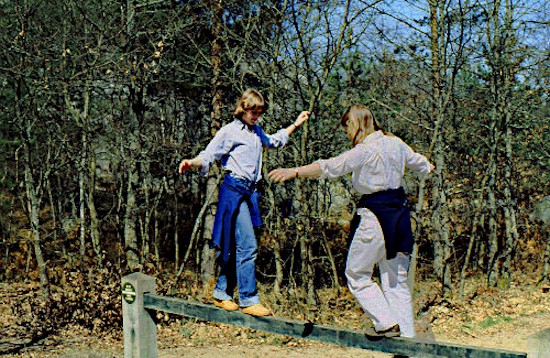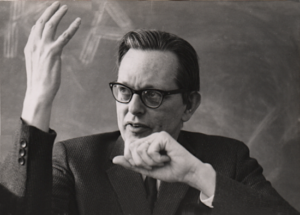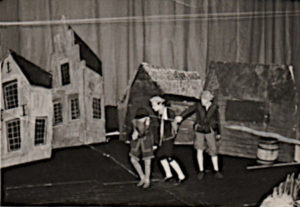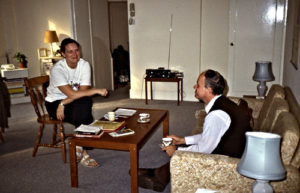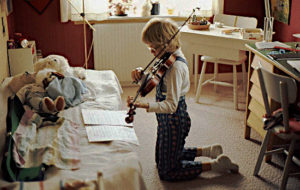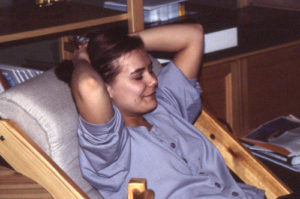When our niece Kajsa was to spend one year in Paris, studying ‘Langue et civilisation françaises’ at the Sorbonne, she was the first in a long line of young girls who first came to stay with us and then moved out to a rented room in a family or for Kajsa’s second year, at the Maison de Suède, in la Cité Universitaire.
Kajsa first spent a year in Paris in 1974 which I already talked about (Chapter 26 – Part 1). She came back in 1975 and this time she was living at the Maison de Suède in La Cité Universitaire, thanks to an uncle of Arne’s who had donated a share of his fortune to la Maison de Suède, uncle Harald Jacobson, farbror Harald, as Arne called him, who had in fact taken over Tante Gerda’s father’s import business which was later sold to NK, Nordiska Kompaniet in Stockholm.
We were going about this a bit late, and it was already just about time for the beginning of the school year. However, I wrote a letter to the Board of Governors, and when they found out from my letter that we had a donator in the family, Uncle Harald Jacobson, they offered Kajsa to share a room with another girl student, who turned out to be our new friend, Lillan, also introduced in a prevision chapter. (Chapter 26 – Part 1)
Lillan and Kajsa were probably the only ones, well, also including Arne, who ever read my very first book, written in Swedish. It was not a book I am proud of, and it is now living in a drawer in what we call the Swedish chest, since it has been with me ever since I lived in Sweden. Everything I have ever written, poems and all, short stories, a play never performed that actually was not bad, are now hidden away in a drawer or two in that Swedish chest. My play was judged to be too static by the Swedish Radio, whom I sent it to. I referred to Claes Hoogland, a friend of Arne’s whom I knew fairly well. He was for many years the head of the cultural sector (producent och teaterkrönikör) of Swedish radio and I had asked his permission to refer to him. If I had not done so, the new cultural director would probably just have thrown it aside without even answering me. But it really was not a bad play, though a bit static, as they said.
One day I will dig up all those old writings and remind myself of the titles of those lost and mediocre ‘oeuvres’. I wrote masses of poems that were all lugubrious. I purged myself of dark memories from the past in writing those poems. Even, in one poem, after cousin Leif had committed suicide in Tampa, Florida, I blamed my grandfather’s harshness and his demands on his descendants for Mother’s collapse and for this suicide which really shook me badly. That was not fair. She had demanded too much of herself and had – indeed – lived up to her standards for many years as the star photographer first in the city of Malmö and then, added to that, at our new Malmö Stadsteater. I have written a chapter just about Mother and her great artistic and technical talent and knowledge.
However, when Arne ended his career as a theater director at Malmö Stadsteater, and Mother then also ended her own career as the prima donna theater photographer at the end of 1948, life became too heavy a burden for her. After they moved to Nyköping she barely managed to stay above the surface of the sea of dull nothingness below her. She was no more the star that she had been in Malmö and, according to the way she saw herself, that meant being nothing.
Arne had his deep-seated self-confidence, which saved him, and he never cut his bonds to the theater or lost his friends from the theater. He organized the performances by Riksteatern in Nyköping and often invited the entire company to their home, well, our home, after the performances for a late supper. He would certainly use a catering service for those suppers. Mother stayed in her room.
What kept Arne busy and happy through all the years in Nyköping was the mini-theater he created at the Gymnasium, complete with stage set artists, costume makers, make-up specialists and whatever else it takes to create theater. Arne even managed to get Dramaten to give them a lot of costumes and wigs they didn’t use any more.
A former student of Arne’s, Rolf Samuelsson, whom I got in touch with via these memoirs sent me pictures of Arne and of several plays they had put on during his four years in the Gymnasium in Nyköping.
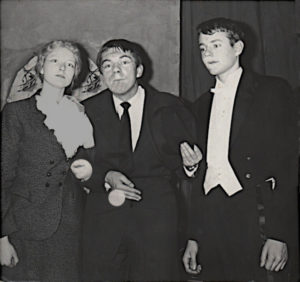
“The Melody That Got Lost” — the “Dream Lord, right, Larsen in the middle and very likely fru Larsen on the left.
Among the several plays that Rolf had pictures from there was “Melodin som kom bort” (The Melody that Got Lost) by the Danish playwright Kjeld Abell. This play made history in the world of theater.
In the picture Larsen looks like the Little Man, as he should. The young girl on the left is Edith, fru Larsen.The Dream Lord on the right in formal evening wear is played by Rolf Samuelsson. He is the persona that Larsen dreams of being in his fantasy world — a small part according to Rolf himself.
The play is about the Little Man (“den lille mand”), here named Larsen, and it picks up a tendency of the 30s of centering on the white-collar worker and taking the part of the Oppressed against the Oppressor. Abell does this even more overtly in his following plays.
Music is heard in snatches throughout the play (the melody that got lost) but after many disillusions, Larsen and his Edith triumph and the song becomes complete. “The play’s relatively open, yet positive ending appears as a tribute to the free spirit, to the free will and to doing something ‘for all of us'”, writes Tina Brødsgaard Andersen. “Larsen breaks out of the everyday treadmill and together with his wife he not only finds the melody again, but he also finds his own free will and follows it.”
Arne managed like no one else, I believe, to get the students enthusiastic about participating in the various activities that are involved in putting on a play, from acting to costume making.
Another play that Rolf had a picture from was “Lax, lax lerbak” which is a historic play about Stockholm through the centuries, from 1948, by the Swedish writer, playwright and poet Alf Henrikson.
Arne even gave classes in theater, very much like the U.S. classes called ‘Speech and drama’, where I was so very fortunate to participate in a few of the productions at Mamaroneck High School. Arne performed short plays, e.g. ‘Herr Sleeman kommer’, one of Hjalmar Bergman’s three marionettspel, where Arne himself had to play the part of the elderly Herr Sleeman. The young men in gymnasium were very willing to help with stage sets and costumes, along with the girls, but they were not as willing to perform on stage.
One day when I was dealing with Mother’s theater photos, around 2015 I guess, I wanted to read two of Hjalmar Bergman’s Marionettspel and, when opening the book which I found on one of my Swedish bookshelves, a newspaper clipping fell out, which to my great surprise and joy talked about Arne’s production of ‘Herr Sleeman kommer‘ and generally about his teaching theater in the gymnasium and the cooperation of the students.
Finding the book did not really surprise me since I have all of Hjalmar Bergman’s novels, but I had completely forgotten that I also had Arne’s copy of Marionettspel. Hjalmar Bergman is my favorite Swedish writer, and I feel very moved by the extremely sad life he lived. He died in Berlin in 1931 at the age of 48, as a wreck — a premature death due to his abuse of alcohol and narcotics. He was a homosexual at a time when that was a definite taboo. He was not good-looking and he clearly never accepted himself. How very sad that one of Sweden’s greatest writers came to such an unhappy ending in a town in Germany, forgotten by his friends.
His novels were, however, very much appreciated even during his lifetime. They are all quite pessimistic, but Bergman also had a great sense of dark humor and sometimes not so dark humor, which made his wonderful novels become the masterpieces they are. He also created a world around a fictitious town, Wadköping, which was modeled on the city of his birth, Örebro, in the center of Sweden. Most of his uniquely wonderful novels took place in and around Wadköping. It makes my thoughts go directly to William Faulkner and his Jefferson and Yoknapatawpha County. Now there is another writer who is unique in his own way.
I remember one day when I was still quite young I said to Arne that my latest coup de foudre (great and sudden love) was Hjalmar Bergman. Arne said “You can do worse”. Typical Arne kind of understatement.
Back to Arne and his position as a gymnasium teacher in Nyköping – to my great amazement and admiration he had the students perform Act II of Mozart’s “Marriage of Figaro”. He actually had to find a lady in town to guest perform in the part of the countess, but Cherubino and the other parts were sung by students. Or it might have been the other way round since Cherubino has the fabulous aria ‘Voi che sapete che cosa è amor in Act II, one of the most beautiful mezzo arias ever written. I saw the performance and it was definitely good. I remember Arne saying he had a lot of difficulty with the oboes to get them to play in tune. No wonder, but I suppose it worked out well in the end. It sounded fine to me, and I am not easy to please in terms of music performances.
Well, back to our Swedish girls who have all been remembered by both of us with great fondness. There was my great friend Britt’s daughter, Katarina, who spent quite some time in our guestroom, but also, like all the other young ladies, after a while found a room with a family. However that room was far too barren for ordinary comfort and we lent her an armchair, a low table and other little things that were missing, things that made her life more comfortable. She also, like Kajsa, studied Langue et civilisation françaises at the Sorbonne. She was already fluent in English after a year’s staying with a family in an up-scale suburb of Detroit and attending high school there. She is a true artist and she has sent us some specimens of her own art as Christmas cards a couple of times, and, later, she keeps sending photos of herself and her young family, husband Anders and their two girls, Anna and Lisa, Anna now being 18 years old.
In 1982 our younger niece Sara arrived to also spend a year studying ‘Langue et civilisation françaises’ at the Sorbonne , And that is clearly why, even though she went on to become a physicist, she still handles French perfectly well and reads French books in French. Unusual maybe for a physicist. She found a room in the somewhat grubby Maison de l’Asie du Sud Est. at la Cité Universitaire, but she was very much part of our family.
Sara was the musician in the Agrup family. I remember her accompanying us to Lars Schmidt’s theater once, le Théâtre de Montpanasse, and also to a concert with the wonderful violinist, Itzhak Perlman, whom she admired very much, being herself a violinist. She later changed to the piano though, since playing the piano is better suited to solo playing. With a violin you would normally like to play in a trio, or in some combination with at least one other instrument. But she has never let us hear her play, even though I am sure we would love to listen to her playing. In fact, I can’t wait to hear her play and she just has to let us hear her one day.
And later yet, my very long-time friend Ragnhild’s youngest child and beautiful daughter, Nina, came down to spend quite some time with us. She brought a wonderful present from Ragnhild, a couple of gorgeous handmade snaps glasses, delicately shaped and with streaks of a clear blue in the glass. Every time I talked to Ragnhild on the phone after that, I meant to tell her how we love those glasses, but I am not even sure now that I ever got around to mentioning it. My dear friend Ragnhild, a widow having lately moved back to Stockholm from the most gorgeous region called Bergslagen, in the center of Sweden — I don’t think she ever put her roots back in the big city. She did have her four children in Stockholm, and I know that Nina especially saw her very often. However, somehow she got tired of living and, very sadly, she left her friends and family a couple of years ago.
A very different kind of Swedish girl was Kajsa’s and Sara’s cousin, Lotta. She never stayed with us, at least not for long, since she was studying French in Tours, but we saw a lot of her. She had also spent quite some time in England and, like the other girls, she was very fluent in English, which is a lucky thing since we speak English in this family.
________________
And there was Christine.
One day the telephone rang. Christine was calling me from Boston asking if she could come and stay with us for a while. I am desperate she said. Things have become unlivable here. I said ‘Come’, without any hesitation.
Later on a letter arrived where she explained a little bit of the more than awkward situation she had gotten into. She was sharing an apartment with two guys, one of them being her boyfriend. Christine was a tall, very attractive and highly intelligent girl who had been in a French class of mine, probably in her senior year. She was sitting at the very back of the class trying to get out of my focus since she rarely did her homework. I still called on her once in a while, I remember, and she usually got out of it fairly well, prepared or not prepared.
The last time I had seen her was at Homecoming day at Mamaroneck High School a year after her graduation. She was then a student at Boston University. She sat down next to my desk and told me that she had only come back to see me and Neil Slater, the music teacher. Well, she said Mr Slater. She came from a wealthy Larchmont family but she despised her father. I believe that she already told me at that time that she went to evening classes at Boston University and worked on various jobs during the day, so she would not have to accept money from her father. That was brave.
We had a nice chat and she must have told me then quite a few facts about her working to support herself. She was and is a novel by herself. I have no idea how she got my phone number in Paris. And how did she ever know I (we) had moved to Paris? No wait, I remember now that she once gave me a book called ‘Teaching as a Subversive Activity‘–- by Neil Postman – which I read with great interest. So we must have stayed in touch even after my divorce and marriage to John.
So out of the blue, she called me one day for help in a next to insoluble personal dilemma and I never hesitated. Of course I would do my best to help her out. In the letter that followed she told me she was easy to live with and that she even put the cap back on the tooth paste. I did a second turn. I always brought my own tooth paste when I traveled, but let’s not be too bourgeois I was thinking. It was really very funny.
I picked her up at Gare du Nord. Why at the train station I don’t remember at all. But that’s what it was. But probably, in those days, you took the train from Charles de Gaulle airport in Roissy to Paris.
She moved in and everything was great. She and John got along very well. I remember her whenever she happened to find herself with the serving spoon in her hand, she would say in her low-toned kidding voice “I did it again.”, which John and I still say when we happen to do the same. She became family. Everything was cool.
Christine liked to dance and right away she found ‘des dancings’ in town, something I didn’t even know existed. In the mornings, or rather the following evening at dinner – John always has ice cream for desert (which I skip) and we began to realize that once in a while some birds had been pecking at the ice cream box from the freezer, chopping out hard ice cream with spoons, clearly eating straight out of the box. Oh well, we laughed.
One day Christine told us that she had been invited out for dinner with Howard Zinn. John and I were stunned. OK, Howard Zinn had been her teacher in political science at Boston University. But we had no idea that they were such close friends. I stupidly said ‘Oh, do you think we could come along too.’ We had read Zinn’s ‘A People’s History of the United States’, and we admired him greatly. She asked Howard Zinn who said that No, he would prefer to have dinner with Christine alone. We both felt a bit silly. Or was it just my suggestion and me feeling silly? I don’t quite remember. Anyway, it was pretty clear that Howard Zinn and Christine had a true friendship going. He must have been struck both by her intellect and by her blonde and sensuous appeal. Howard Zinn was not a young man any more, but what does that matter for a true friendship? And it did not surprise me that Christine had been remarkable as a student.
________________
One morning we realized that she was not alone in her room. We had a big bed in the guest room at the time which had been our own bed in New Rochelle. It was later replaced by a sofa-bed that is right behind me here in my study in Genas, as I am writing. And with the wonderful big desk also from New Rochelle, which John and I had put together from three pieces bought at an untreated-furniture store. I am sitting at it right now and I still love it. Big and solid and stained dark brown. Those two pieces, a big white ‘armoire’ and an armchair were all the furniture there was in that room, which was our guest room and my study. On the desk was my electric typewriter with a Swedish keyboard. When I started writing seriously, in the late 70s, it was in Swedish, and we bought me this German electric typewriter, where you could get any character sets you wanted. Little by little, I began to write my poems and stories in English instead. But computers were still far ahead in the future for personal writing purposes. (I did in fact write my prémémoire in 1987 for my DEA in linguistics on a computer I had borrowed from my school over the summer. I was using one of the earlier word processors that our technician had taught me to use.)
OK, Christine had a sleep-over guest in her room and I didn’t like it. Ever after I have often felt that I was old-world old-time, the way I didn’t just laugh it off. But I couldn’t. I liked having guests, but I wanted to invite them myself. So after talking it over with Christine who had already been staying with us for about a month, it was decided that she would try to get an au pair job somewhere. She was very lucky — maybe she was born with a silver spoon in her mouth. She got a job with a Spanish speaking woman in a southern Paris suburb who quickly became her friend. Christine managed all right in French too, but she was fluent in Spanish.
What followed after that, however, was the real fun turn of events. Christine and John and I still remained friends and she came to see us on and off. Where she got to know Mary is more than I will ever know, but one day she told us she was working with a very smart and good-looking young English woman who ran a restaurant on l’Île Saint-Louis of all places. It was called – what else? – Mary’s restaurant. Christine seemed to manage at everything she set her mind on. She had worked as a waitress, she had worked in a florist’s shop in Boston, and now she was working as an assistant chef with Mary.
I just did a search and Mary’s restaurant doesn’t exist any more. Mary, by the way, married an ambassador, and that is all I know about her life – after Christine. The restaurant became a real hangout for businessmen who didn’t mind vegetarian food, since that was all they served. One day they had a reservation for a large group of businessmen and they were going to serve them ratatouille, a wonderful French dish with loads of different vegetables, from eggplant to tomatoes, onions, bell peppers and garlic, entre autre. All the vegetables are chopped and mixed together with olive oil in a huge pot, at least in this case. The liquid is provided by the vegetables.
Now, this is the story. Christine was stirring the big pot and when the vegetables looked done, she put the spices in, salt, pepper, and maybe something else. (I have never cooked ratatouille.) A little later Mary who had clearly had her back on Christine, happily went ahead and put her spices in. Or was it the other way around? When they tasted it, they didn’t know if they should laugh or cry. Mary said to Christine “Fix it”.
There was only one thing to do, and Christine was never short of answers in a tricky situation. She poured the entire contents of the huge pot into the sink, well stopped up of course, poured lots of water over it and kneaded the mixture almost like a dough. She spooned it back into the pot and they served it to the very correctly dressed gentlemen, tie and all. Everybody loved it. They had never had better ratatouille.
However, the day came when Christine announced to us that she was getting married. We didn’t have the honor of meeting the man until the wedding which was a jet-set affair in the apartment of someone we did not know. John and I felt that we definitely didn’t belong and we did not stay long. After handing over our wedding present, which was probably some Swedish Kosta glass thing, or things, we made our bye byes and left. There used to be a store on l’Île Saint-Louis where they sold Swedish glass, and I know that we bought some Kosta snaps glasses for the wedding of our very dear friend Andy and his young bride, Trudy.
Pierre-Yves, which was the name of the groom, belonged to a very bourgeois family He actually worked with the World Bank planting trees in Africa, even though he had a ‘Grande Ecole’ education. Les diplômés des Grandes Ecoles are usually very ambitious and eager to make a good career. Maybe working for the World Bank was the beginning of a good career. I just know that my students at Ecole Centrale would certainly not go and plant trees in Africa. Christine and Pierre-Yves lived in Cameroon to begin with, then, later on, in Gabon. Christine came to see us before they moved to Gabon, and she seemed happy enough.
At one point during that time Christine gave birth to a baby at a Paris hospital, l’Hôtel-Dieu if I remember right. We went to see her with flowers of course, and Christine had a huge room to herself. What I remember best from that visit was how Pierre-Yves barely said Bonjour to us and stayed all the time we were there glued to the window, looking out and deliberately ignoring us. Christine was her usual self, always low-keyed, but seemingly happy. Was it possible that he was the one who had stayed overnight in Christine’s room. No, I don’t believe so. That would not fit in well with his bourgeois background.
At one point they also lived in Ireland where Pierre-Yves had a big house. After that we had very little news from her. She did let us know that she had one more child and then she moved back to Boston. I remember one time when I asked her how she could stand all the heat in Gabon at the time. I naively asked if they kept taking showers all day with all the sweating they must do. In her usual low-keyed voice she said ‘You sweat’. Point final.
However, later on she told us that Africa gave her depressions and she could not stand it any more. Did Ireland depress her too? Dear Christine, I would love to get back in touch with her.
Continued: Chapter 32 -– Travels around the USA in 1979





